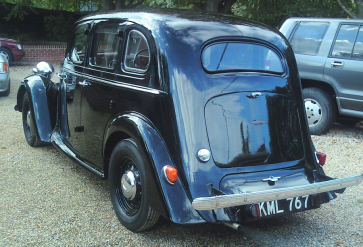
This tastefully restored 1939 Super 12 formerly belonged to Norman McKinnell.
Norman tells us:
“I have always been a car nut, and as a result have a number of ‘collectables’ acquired over the years – mostly Mercedes. Recently my passion has changed to 60s and 70s cars – must be the ‘mod’ in me.
I never realised Singer actually made cars in the 1930s until I went to an auction to purchase a Mercedes Pontin for restoration. However, the vehicle sold for an inflated price and I was left empty handed.
The next auction lot was a 1939 Singer Super 12 that had 3 recorded owners and bills showing expenditure of £5,600 in 1964. I immediately decided she was the one for me, despite no MOT, looking a bit down in the dumps and in need of some TLC. Two minutes later, I was the proud owner and couldn’t wait to get her home and tucked up in a warm garage.
With the help of a very nice Russian man at the local garage, she was steam cleaned underneath, the chassis and running gear painted with Hammerite, and the engine in some specialist engine paint.
The engine oil was white and milky, but after the engine had been flushed numerous times with the external filter removed (whatever good it is I’m not sure), my fear of water troubles were eventually unfounded. Everything that had a grease nipple was greased and everything else that should move was given numerous doses of 3 in 1 oil until eventually things appeared to be functioning again. Steering and brakes were checked, carburettor, plugs and points cleaned, and she then fired up and ran as beautifully as she was designed to do. I also decided to tidy up the wiring – I’m not sure why it still looks a mess, but at least I feel I’ve had a go!
So now it was MOT time and off I went with trepidation. On route, the wipers packed up, but I pressed on, and on arrival announced her shortcomings to the MOT man, who promptly allayed my worries by stating: “If you have driven it 5 mile , it pulls up in a straight line and the lights work you should be ok”.
“Excuse me,“ I replied in a sheepishly, “What about the wipers?” “ Windscreen opens, so you don’t need the wipers.” A wave of relief came over me – I could never close the windscreen completely anyway – more 3 in 1 I guess. She passed, I was so proud of her. A small gathering had appeared, and although they were not supposed to look at her under-belly when on the ramp, the tester permitted them – what a nice man – and what lovely curious people, who all made complimentary remarks about the condition of her underside.

I drove away from the garage feeling 10ft tall, and all her quirky ailments such as clutch judder, a driver’s door that seemed it had come from Colditz and needed an enormous bang to open, the draught from the road as the gear box cover was missing, no power steering, an open windscreen, two front seats that had more horse hair stuck out either side of them than my other great love Red Rum, and a gearbox that occasionally needed a double declutch to negotiate a roundabout, to name just a few, were all forgotten.
The next stage was to tackle the doors. These were hanging at all angles and when closed the bottom third protruded outwards like wings. In addition, rust was clearly evident along the bottoms and creeping at an alarming rate, consuming large areas of the door. It was time for a visit to my favourite body shop, where John advised a course of action, including renewal of some timber elements.

When I went to collect her it was like the King and his new clothes, what a pleasure to see. This spurred me on to tackle the interior. I decided to try and salvage the seating, after all, they had been made by craftsmen over 70 years ago and I felt it was important to recognise this. Stitching that had come apart was re-stitched, horse hair replaced, springs repaired and then all treated with leather food – the patina is lovely. New, matching carpet was fitted by the ‘seat’ man, who bound all the edges and did a great job.
I’ve now owned the car three years, and although she seems almost finished there will always be something that needs doing. The winter will hopefully allow me to tackle jobs such as painting inside the boot, fixing the hamper I commissioned, and attending to the roof lining and the sun visors. The limited paperwork that came with her, including the Shellubrication plastic wallet, shows that in 1964 at 5,992 miles a full service was carried out. The final service sheet in 1971, by which time she had recorded 13,790 miles, bears a technicians note ‘Next service 14,700 miles.’ The mileage now is 15,985 – I bet she could tell a story or two!
So here’s to the next 72 years – bottoms up and drink to a lovely old girl.”


